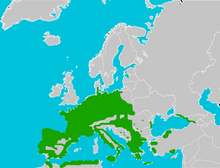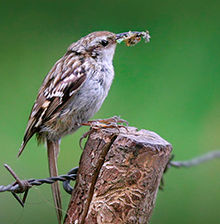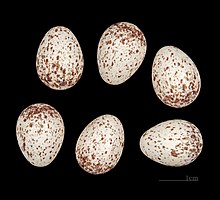Treecreeper
| Treecreeper | ||||||||||||
|---|---|---|---|---|---|---|---|---|---|---|---|---|

Treecreeper ( Certhia brachydactyla ) on a birch |
||||||||||||
| Systematics | ||||||||||||
|
||||||||||||
| Scientific name | ||||||||||||
| Certhia brachydactyla | ||||||||||||
| Brehm , 1820 |
The treecreeper ( Certhia brachydactyla ) is a bird art of the genus of authentics treecreepers ( Xuanmu ) from the family of the creeper (Certhiidae). It is a common breeding bird in large parts of Central Europe , which can be found mainly in the lowlands.
The horticultural tree creeper was classified in the IUCN Red List of Threatened Species in 2016 as “ Least Concern (LC) ” = “not endangered”.
description
The treecreeper is so similar in appearance to its relative, the treecreeper , that the two can hardly be distinguished from one another. In field observations, the utterances are usually used to distinguish the two species.
The treecreeper reaches a height of 12 centimeters and weighs about 11 grams. Its pointed beak is curved downwards and becomes up to 12 mm long. Its underside is white, its upper side is bark-colored and its upper eye stripe is white. Males and females are the same color. Its relatively long tail is used for support and control in flight. The middle tail feathers in particular are particularly stiff to enable support.
Newly hatched nestlings of the treecreeper have long gray dunes on their foreheads and necks. The throat is yellow and the beak ridges are yellowish white.
The call of the tree walker sounds something like "tihtih". The singing is shorter and overall stronger and louder than that of the treecreeper. The melodic short whistling stanza resembles a "titi-tiro-iti-titt" or "di-dideli-di-di".
Climbing tree trunks is typical of the treecreeper, where it supports itself with its long tail and moves upwards in small jumps. It is particularly common on deciduous trees such as oak, ash and elm, which have particularly deeply furrowed bark.
Distribution area and habitat
The habitat of the treecreeper is western and central Europe, the eastern border is slightly east of the eastern border of Poland and on the western Black Sea coast. It also breeds in southern Europe, western Asia Minor and North Africa. It is absent in Great Britain and Ireland, as well as in northern Denmark. It is also missing in large parts of the interior of the Iberian Peninsula.
Unlike the treecreeper, the treecreeper prefers deciduous forests, parks and gardens with many fruit trees . It can also be found in avenues, field trees and orchards .
The treecreeper hibernates as a resident bird in Central Europe and is a barnacle and short-range migrant .
nutrition
With their plumage, tree creepers are ideally adapted to the bark of the trees, where they hunt for food well camouflaged. For foraging, the treecreeper prefers deciduous trees with particularly deep, barky bark (e.g. oak , ash , elm ), which it searches for food. This consists of insects , spiders , beetles and larvae , which he finds on and under the tree bark. It also feeds on seeds, which can make up a larger part of its diet, especially in winter.
Unlike the nuthatch , the treecreeper cannot run down the tree trunk upside down. It begins at the lower part of the tree and, with the help of its long pointed claws, climbs the tree trunk in a jerky and screwy manner. He pokes with his long, clearly curved tweezers beak in the tree bark for anything edible.
The treecreeper is rarely seen as a guest at artificially created winter feeding grounds. If he does find himself at a bird feeder, he prefers fatty, soft winter food.
Reproduction
The breeding season extends from March to July. Treecreepers raise one to two broods a year.
The nest is built from sticks , stalks , moss , animal hair and feathers in tree crevices and behind loose bark. The inside of the bowl is lined with feathers, bark fibers and wool. Both parent birds are involved in nest building. The female lays five to seven eggs . These are spindle-shaped with a smooth, lusterless white shell, which is very finely speckled or dotted rust-red or -brown. It only breeds the female, the breeding season is up to 13 to 15 days. The young leave the nest after 14 to 15 days. Both parent birds are involved in the care of the young birds. The sexual maturity occurs after one year.
literature
- Einhard Bezzel: birds. BLV Verlagsgesellschaft, Munich 1996, ISBN 3-405-14736-0 .
- Collin Harrison and Peter Castell: Fledglings, Eggs and Nests of Birds in Europe, North Africa and the Middle East. Aula Verlag, Wiebelsheim 2004, ISBN 3-89104-685-5 .
Web links
- Species profile of the garden tree creeper at www.natur-in-nrw.de . Retrieved January 4, 2013
- Profile and pictures of the treecreeper u. a. when eating
- Certhia brachydactyla in the endangered Red List species the IUCN 2008. Posted by: BirdLife International, 2008. Accessed December 29 in 2009.
- Winter feeding of wild birds on wildvogelhilfe.org . Retrieved January 4, 2013
- Videos, photos and sound recordings of Certhia brachydactyla in the Internet Bird Collection
- Swiss Ornithological Institute Sempach: Treecreeper
- The plumage of the treecreeper
- Age and gender characteristics (PDF; 0.8 MB) by Javier Blasco-Zumeta and Gerd-Michael Heinze (English)
Single receipts
- ↑ Certhia brachydactyla in the endangered Red List species the IUCN 2016 Posted by: BirdLife International, 2016. Accessed November 20, 2017th
- ↑ Bezzel, p. 482.
- ↑ a b Harrison, p. 411.
- ↑ Lars Svensson, Peter J. Grant, Killian Mullarney, Dan Zetterström: The new cosmos bird guide . In: Kosmos Naturführer (Ed.): Kosmos . Stuttgart.
- ↑ Bezzel, p. 462.
- ↑ Species profile of the garden treecreeper on natur-in-nrw.de . Retrieved January 4, 2013.
- ↑ Bird feeding in winter - who eats what? Wildvogelhilfe website at wildvogelhilfe.org ( memento of the original from March 10, 2013 in the Internet Archive ) Info: The archive link was inserted automatically and has not yet been checked. Please check the original and archive link according to the instructions and then remove this notice. . Retrieved January 4, 2013.
- ↑ Harrison, pp. 410-411.


